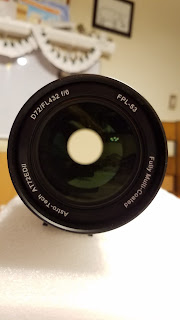The Big Day finally arrived!
I was out in the yard at 5:15 AM, accompanied by my very confused cats, to set up and polar align the Vixen Super Polaris mount.
My younger son stayed home from school to view the event (and play video games). The sky looked good. The equipment was ready. We went to the store to buy fresh batteries for the mount, then...
clouds
Yes, I wrote it. The "C" word. The
bane of astronomers, both amateur and professional, everywhere.
I'd been looking forward to this day for years. In fact, I was already disappointed that I wouldn't be able to travel to see totality. But this...
This.
It's not unusual to have early morning clouds during humid, East Texas summers. But the timing...
But we amateur astronomers are an optimistic bunch. In fact, astronomy is one of the few things in which I embrace optimism to any degree. It's not in my personality to expect the best. However, I've been known to sit under overcast skies with the belief that, eventually, they will part and the skies will be clear. Sometimes I'm right. Too often, I'm wrong.
Still, I pushed forward and finished setting up the rig.
A couple of minutes after first contact (the point at which the Moon begins passing in front of the Sun), the clouds started to break up. I won't say that it was smooth sailing from that point forward, but as the day progressed the clouds became less of an issue.
The neighbor's landscaping crew, however, chose today to mow her lawn. Imaging had to be shut down temporarily to protect the equipment from dust.
I couldn't get the ST80 and PST to play nicely together, so I just concentrated on using the PST.
Most of the images made with the PST below are stacked images, meaning they are composed of several individual images that were digitally combined to improve detail and sharpness.
Anyway, I guess I've wasted enough of everyone's time talking about it. Let's get to the pictures!
First up, here is the rig in its final form, doing its job. I cobbled together a sun shield for the laptop out of a cardboard box. A laptop cooling pad and ventilation holes in the box kept the computer cool and comfortable.
I also made a simple pinhole projector camera. Here, my son is holding the paper while we look at the image.
A colander also makes a decent pinhole projector, with an interesting pattern:
 |
| This image was taken during the peak of the eclipse from my location. |
This is one of the earliest images that I could obtain due to the clouds:
I never found a way to eliminate the Newton rings, or whatever the bands across the Sun are.
Incidentally, I'm using a different shade of yellow now--a little closer to the color of the Sun in my white light filter. (Since I'm using a monochrome camera, the original images are in black and white.)
In this image, sunspot group AR 2176 has been completely covered.
Nearing the peak! The Sun is smiling and has something stuck in its teeth.
This image is a composite between two exposures taken near the peak: a shorter exposure to get the detail on the Sun's disc, and a longer one to highlight the relatively dimmer
prominences (the streams of plasma seen along the outside edges). The two images were combined in Photoshop. Each image is a single shot (not stacked).
This image was taken a little later, but composed of stacked images. Note the greater detail on the surface and in the prominences.
Here, the Moon is almost past the Sun. I somehow managed to accidentally switch the camera to a lower resolution, so this image is smaller than the others.
 |
| I like to call this one The Death Star. |
Other than a small swarm of
love bugs, there weren't as many visitors in the images as there were during the
Venus Transit. However, a few vultures flew overhead near the end, and one got caught on camera:
It was a fun day, and I'm glad the weather held out enough to see the majority of the show. The next total solar eclipse in North America will happen in 2024. I can't wait!



































